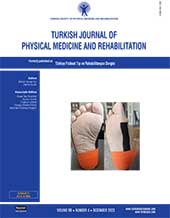The effect of Tecar therapy on neurological disorders and nerve conduction velocity of lower limbs in peripheral neuropathy of type 2 diabetic patients: A six-week follow-up study
2 Physiotherapy Research Center, School of Rehabilitation, Shahid Beheshti University of Medical Sciences, Tehran, Iran
3 Student Research Committee, School of Rehabilitation, Shahid Beheshti University of Medical Sciences, Tehran, Iran DOI : 10.5606/tftrd.2023.11875 Objectives: This study aimed to investigate the effect of Tecar therapy on neuropathy symptoms and tibial nerve conduction velocity in individuals with diabetes.
Patients and methods: The single-blind, randomized, sham-controlled clinical trial was conducted between January 2019 and October 2019. Twenty-four type 2 diabetics (8 males, 16 females; mean age: 60.4±8.9 years; range, 40 to 78 years) with peripheral neuropathy were randomly allocated to control (n=12) and study (n=12) groups. The study group received the capacitive Tecar therapy with 10 to 30% intensity and infrared radiation in 10 sessions. The controls received the same protocol with zero intensity. The neuropathy symptoms and nerve conduction velocity were evaluated at baseline, after 10 sessions, and six weeks after the end of sessions.
Results: There were no significant differences in variables (p>0.05). In this way, the homogeneity of the data variables was confirmed. Moreover, the results of two-way mixed analysis of variance showed that improvement of neuropathy symptoms in the study group was significantly more than controls in all stages (p<0.001). After 10 sessions, the results of post hoc analysis showed that the neuropathy symptoms and tibial nerve conduction velocity were significantly improved in both groups (p<0.001). The improvements were still present at six weeks in the study group (p<0.05). However, there was no change in these outcomes after six weeks in the control group (p>0.05).
Conclusion: Tecar therapy could improve neuropathy symptoms and tibial nerve conduction velocity in diabetic individuals with peripheral neuropathy. Therefore, the use of this method to control the symptoms of diabetic patients can be recommended.
Keywords : Diabetic neuropathy, nerve conduction velocity, neuropathy symptoms, Tecar therapy
















